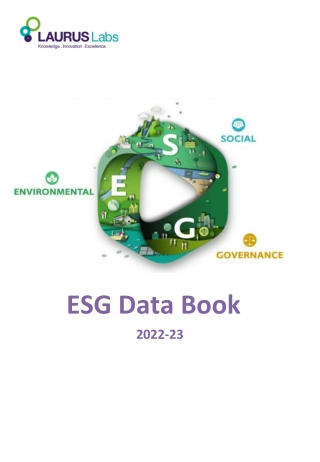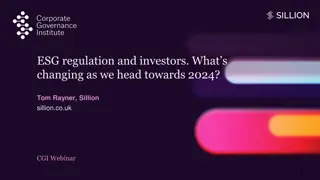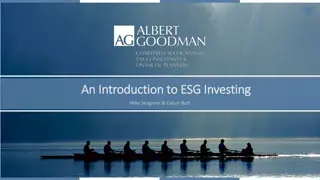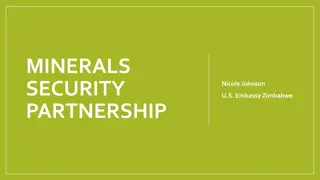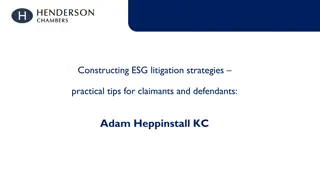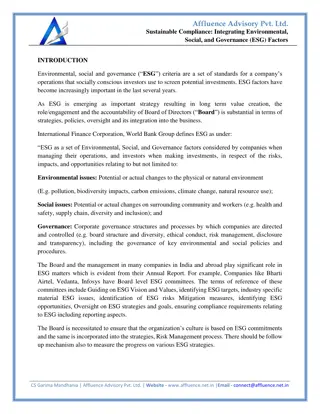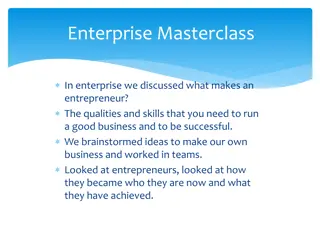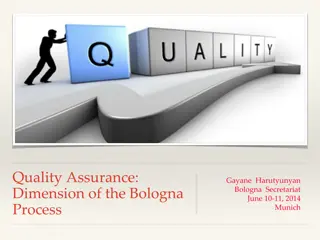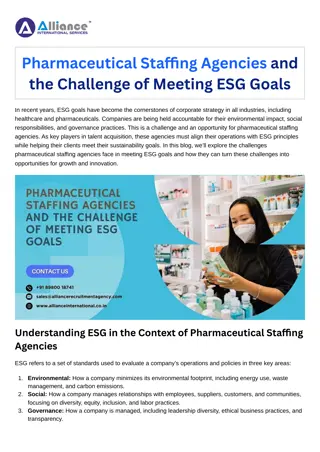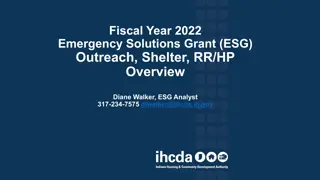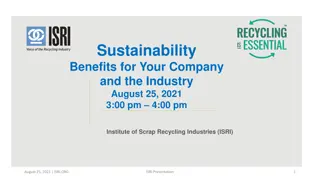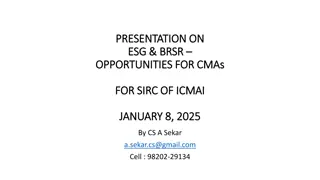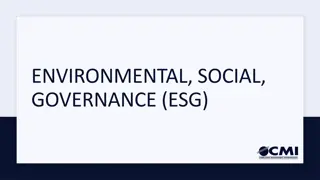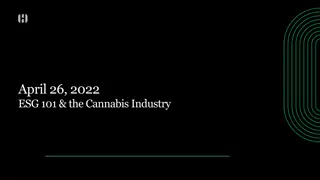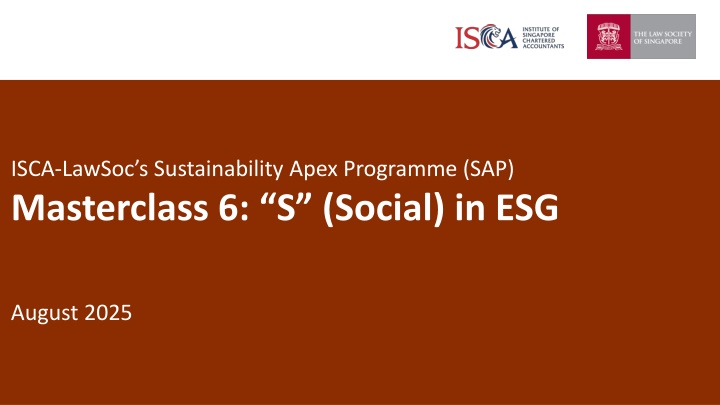
Masterclass 6: “S” (Social) in ESG
Explore social issues in ESG through frameworks and case studies, focusing on human and labor rights, workplace practices, legal landscape, and strategies for fair labor practices. Discover the importance of workplace culture, accountability, and inclusive practices for sustainable business operations.
Download Presentation

Please find below an Image/Link to download the presentation.
The content on the website is provided AS IS for your information and personal use only. It may not be sold, licensed, or shared on other websites without obtaining consent from the author. If you encounter any issues during the download, it is possible that the publisher has removed the file from their server.
You are allowed to download the files provided on this website for personal or commercial use, subject to the condition that they are used lawfully. All files are the property of their respective owners.
The content on the website is provided AS IS for your information and personal use only. It may not be sold, licensed, or shared on other websites without obtaining consent from the author.
E N D
Presentation Transcript
ISCA-LawSocs Sustainability Apex Programme (SAP) Masterclass 6: S (Social) in ESG August 2025 1 1
Agenda for todays masterclass 01 02 03 04 ESG-related Disputes and Resolutions Introduction to Social Issues Human and Labour Rights in Singapore Protecting Human and Labour Rights in Workplace Explore the importance of addressing social issues within corporate sustainability. Gain an understanding of key social frameworks to effectively address them. Explore common social issues through case studies, examining notable examples and strategies for preventing and resolving disputes. Overview of the legal and regulatory landscape concerning human and labour rights, and the implications for businesses operations. Uncover the strategies for assessing and promoting fair labour practices in the workplace, including examples of best practices. 1.1 The Role of Social in ESG 2.1 Current Legal and Regulatory Requirements 3.1 Best Practices for Employers 4.1 Overview of Social Disputes 1.2 Key Frameworks for Social Issues 2
Overview of key social topics Culture, workforce & skills for the future Social contribution Ensuring a safe and progressive working environment that attracts and retains the best talent. Labour practices Culture, behaviour and employee voice Talent management and futureworkforce Building meaningful engagement and positive social outcomes for communities and broader stakeholders. Strategic charity partnerships Community outreach & engagement The S inESG Focus on People Focus on Prosperity Culture, workforce& skills for thefuture Social contribution Inclusion, diversity & equity Climate, nature & the just transition Ensuring that diversity and inclusivity are embedded at the heart of your business, to unlock value and performance. Ensuring that social impacts and considerations are aligned and at the heart of climate and nature activities. Developing a just transition plan, including identifying key social impacts and correspondingmitigation Embedding S in ESG frameworks Inclusion, diversity & equity Climate, nature & the just transition Data, reporting and insights Careers, performance and talent Formal and informal operating models Leadership and behaviours Workspaceenvironment Stories and symbols External relations Human rights & modern slavery Products & customer Human rights & modern slavery Products & customer Ensuring that the value chain protects, respects and remedies human rights and upholds necessary standards and principles. Human rights due diligence, responsible supplier engagement and policy commitments Management systems and controls Grievance & remediation mechanisms Minimum safeguards Understanding the social impact of existing and new products and working with customers to support them on their transition journeys. Product development Distribution channel strategy & management Source: KPMG Global 3
Importance of building workplace culture for the future 5 Core areas in building organization culture Culture however, for many organisations, driving a culture of accountability seems like an intangible feat with many organisations leaping to enhance the operating model without recognising the need to manage the human factors. This can be a costly oversight and without considering a unified approach and accountability, the desired benefit and return will not be realised. and Accountability are not new concepts, mindset to drive What isCulture: Organisational culture determines how an organisation operates and gets things done in response to internal and external changes. What isAccountability: Accountability refers to the obligation or willingness of individuals, organisations, or institutions to take responsibility for their actions, decisions, and their impact on others. Source: KPMG Global 4
Overview on Diversity, Equity, and Inclusion Diversity is about difference: a combination of qualities or dimensions that make us unique, enabling us to offer new insights and perspectives as a result of our experiences. Benefits of DEI across all areas of the organisation: Increased Profitability Organisations with ethnically/culturally diverse executive teams are 30% more likely to experience above-average profitability. Equity is about access to opportunities: about fair and just practices and policies that ensure all members of an organization can thrive. Equity includes acknowledgment of structural inequalities historic and current and actions to address these inequalities. Richer Better Brainstorming A diversity of opinions and ideas can lead to richer, more productive discussions during brainstormingsessions. DecisionMaking Diverse teams are 60% faster ateffective decision making than non-diverseteams. Inclusion is about belonging: how organisations realize the benefits of diversity. Foster Innovation Organisations thatcreate an inclusive environment report a 83% increase in innovation. BetterConsumer and Citizen Understanding 49% of employersare focusing on diversity to better understand consumers. Increased Creativity A diversity of ideas and viewpointscan lead to creativebreakthrough. Teams can be more adaptive to changes, to reflect their customers needs. Intersectionality give voice to people impacted by overlapping concurrent inequalities and understand the depths of these inequalities in a given situation Source: KPMG Global, HBR: The Forgotten Dimension of Diversity (Link) 5
Human rights risks, a rights holders-centric approach Examples of Human Rights Risks that the Private Sector Faces Employees or customers facing discrimination by race, gender, sexuality Local communities being displaced by projects Suppliers using forced labor (modern slavery) or child labour Risks to people leadto risks to thebusiness The language of corporate responsibility should not only revolve around risks to the business but also risks to people. Workers and communities being denied the opportunity to raise grievances Security guards using excessive force People s health being damaged through accidents and pollution This people-centric approach can be challenging to integrate into existing ERM systems. Factories and industrial sites providing unsafe working conditions Workers being denied rights such as freedom of association Workers being underpaid Source: KPMG Global 6
Process to design trustworthy organizations 4. Communicate Build trusted brand 2. Assess Develop strategy Listen to understand stakeholder trust and expectations, and identify issue Do you know you your stakeholders are, what are their expectations and how they interact? Are you clear on the root causes of any actual or potential trust issues? Transform to operationalise and embed trustworthiness Can you group issues to focus on priority areas? Do you have a governance office? Who is responsible to deliver organizational transformation? Who is accountable for ensuring they succeed? Assess to evaluate organisation s design and develop trust strategy: How are you meeting stakeholder expectations? Are the identified trust issues correctly prioritised? Can you improve organisational design or implement mitigations? Communicate back to stakeholders to demonstrate you have listened and acted. How are you communicating with your stakeholders? Is the brand strategy aligned to the trust agenda? Is there communications framework in place? 1. Listen Identify issues 3. Transform Operationalize Source: KPMG Global 7

